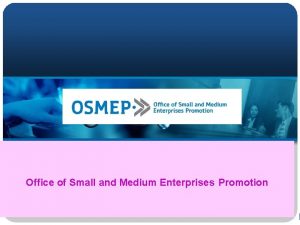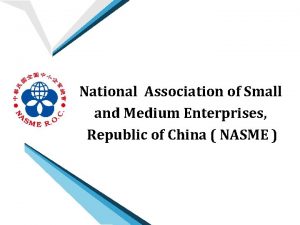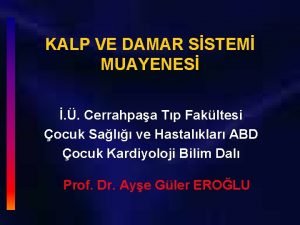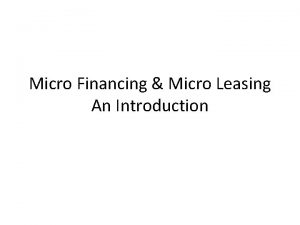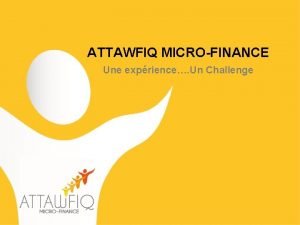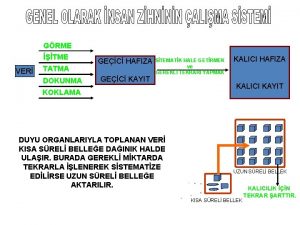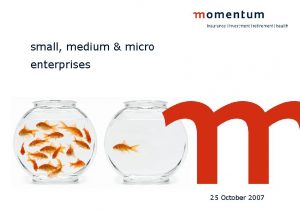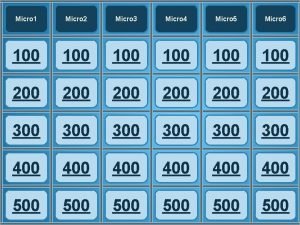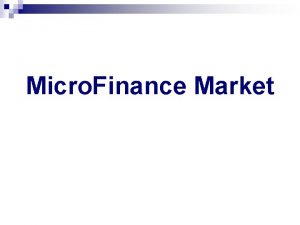MICRO FINANCE FOR MICRO SMALL ENTERPRISES GEC Annual










- Slides: 10

MICRO FINANCE FOR MICRO & SMALL ENTERPRISES GEC Annual Summit 2017 Trinidad and Tobago 2 nd November

Financial Ecosystem Micro & Small Enterprises (MSEs) in India 21. 5 million MSEs in India Finance through non-institutional sources Finance through institutional sources Others USD 650 billion finance demand No finance/self finance 8 out of every 10 MSEs is not USD 140 million served by formal finance 80% finance demand from informal sector financed/ self-financed 37% of the overall debt demand is estimated unviable for financial institutions

Assessment of Financial Avenues Micro & Small Enterprises (MSEs) in India Banks & NFIs Special Purpose Units (SIDBI, ADVANTAGES (Crowd funding) Moderate interest rates 13 - 16% per annum 13 - 20% interest rates per annum 8 -10 % interest rates. Connect philanthropy to entrepreneur DISADVANTAGES NABARD) Market platforms Immovable collateralized debt. Legal compliances cumbersome Unpredictable credit interval. High competition for the funds. Not predictable in terms of follow up credits Micro-Finance Institutions Informal systems – money lenders Lower regulatory overheads Easy access to financial needs (little/no documents) 25 - 30 % interest rates. Collective liability for credit returns & default 25 - 60% interest rates per annum

Features of Financial Avenues Micro & Small Enterprises (MSEs) in India Interest Rates Collective institutional strength as collateral Previous business experience – critical criteria to prevent bad loans Innovation is helping them reach newer markets Market platforms (Crowd funding) Ticket size investment Special Purpose Specific portfolio Units (SIDBI, No credit rating schemes/offers NABARD) available for MSEs Banks & NFIs Lot of paper work and collateral needs Accessibility Micro-Finance Institutions Social contract – easy payback possibility Informal systems – money lenders Fluctuating interest rates Useful for groups and collectives Limited understanding and unpredictability

Micro Finance in India Opportunity for Micro & Small Enterprises (MSEs) Typically • very small-sized loans of about USD 100 • Extended to an individual or a group of individuals • Borrowers are generally from the vulnerable sections of society. Covers about 10 per cent of poor households in need of credit Market size for microfinance in India is in the range of 58 to 77 million clients. Annual credit demand of USD 5. 7 to USD 19. 1 billion Growth Rate - 50 per cent pa even higher than the mobile industry 60 largest MFIs has close to 10 million customers, outstanding portfolio of $769 million

Micro Finance in India Models and Institutions Banks and Financial Institutions Promoter/ Service provider Models of Delivery Self help Groups Model • Innovations • • Company (Business venture for MFIs) Societies and Trusts Grameen Model Individual Banking Programmes Online marketing and crowd sourcing platforms to generate micro finance for entrepreneurs (Case A: Rang De) Revolving fund with local communities to finance rural entrepreneurship (Case B: Credit Facility) MUDRA Bank focusing on micro-finance for micro-enterprise (Case C: Mudra Scheme)

Case A: Rang De The idea of Rang De was sown in the year 2006. The motivation for starting Rang De was the belief that the peer-to-peer lending model could be leveraged to lower the cost of microcredit. Choose Someone: a farmer, a weaver, a tailor, a student, a dairy farmer. Withdraw or reinvest once your investment returns after making a difference and continue the good work. Invest or Donate for their growth, help her stand on her own feet. Create a lasting impact by supporting her loan request in part or full.

Case B: Micro – Credit Facility STEP 1 STEP 2 STEP 3 The Sakhi Saheli Tejaswini Mahasangh (SSTM), an apex women organisation in Madhya Pradesh, provides credit support services to set up and support enterprises. In the pilot conducted by Development Alternatives, its business included: • Supporting three existing enterprises and establishment of nine enterprises in the villages. • Created 10 new jobs in the local economy • Increased income by 20 -50% of new and existing entrepreneurs • Invested INR 650, 000 in the local economy STEP 4 STEP 5 STEP 6 STEP 7 Dissemination of Information regarding the process of applications for support Application Development (Building capacity, support and handhold entrepreneurs to build their business plan) Selection of Entrepreneurs based on expected returns of proposed Business, Ability to Repay, Experience. Agreement with Entrepreneurs stipulating all terms & conditions will be facilitated of loans between borrower and SSTM. Disbursement SSTM finances up to INR 40, 000 to one single association/ entrepreneur. Maturity period < 12 months. Monitoring and Supervision The federation carries monthly audits and checks on the statement of bank accounts. Collection of Monthly Instalments Based on the contract and agreement, the monthly instalment plan is devised.

Case C: Mudra Scheme • Announced in 2015, it envisaged MUDRA loan upto 1 million to micro-enterprises • MUDRA loans are extended by banks, NBFCs, MFIs and other eligible financial intermediaries as notified by MUDRA Ltd. • Refinance corpus of INR 200 billion, and credit guarantee corpus of INR 30 billion • Banks have been mandated not to insist for collateral security in the case of loans up to 10 Lakh extended to Micro Small Enterprises. • 60% shall be allotted only for extreme poor population included SC/STs. • As against the target of INR 1. 2 trillions in 2015 -16, the Banks and MFIs together have disbursed INR 1. 3 trillions, thereby achieving 109% • 34. 9 million accounts financed during the year, 12. 5 million accounts were for new entrepreneurs, which work out to 36%

Thank you

